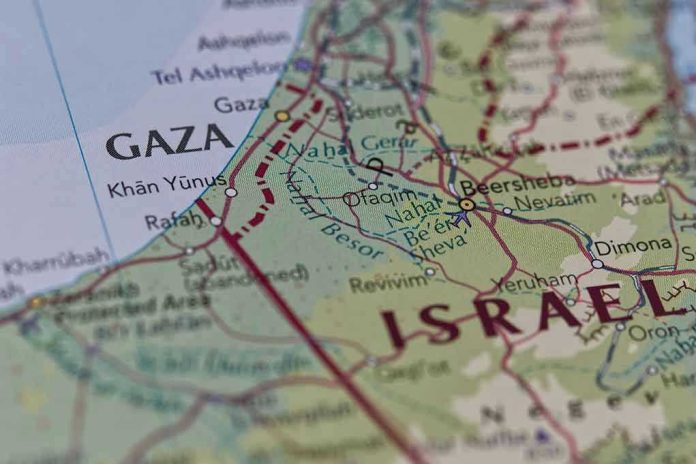
While Gaza’s civilians starve, shocking footage reveals Hamas militants feasting underground, sparking outrage and deepening the humanitarian crisis.
At a Glance
- Israel releases footage showing Hamas militants with ample food amid Gaza’s food shortages.
- Gaza’s population faces severe food insecurity under an intensified Israeli blockade.
- Israel’s new aid distribution plan bypasses traditional channels and aims to weaken Hamas.
- The humanitarian crisis in Gaza continues to escalate with international scrutiny.
Hamas Feasts While Gaza Starves
The Israel Foreign Ministry has released footage that claims to show Hamas militants enjoying a banquet of fresh food underground, while the Gaza strip above suffers from crippling food shortages. This footage, undated and unverifiable, has ignited a firestorm of debate about the priorities of the Hamas leadership amid the worsening humanitarian crisis in the region. Israel asserts that this is proof of Hamas’s blatant disregard for the civilians they claim to govern.
The footage, released on July 23, 2025, by the IDF’s Arabic spokesperson, depicts alleged Hamas fighters surrounded by ample supplies, including fresh fruit, raising questions about the source of these provisions. Israel maintains that these supplies were not part of the humanitarian aid efforts that have been sporadically allowed into the besieged territory. The move is seen as part of Israel’s broader strategy to control narratives and expose what it describes as Hamas’s exploitation of the humanitarian crisis for its own gain.
The Escalating Crisis in Gaza
Gaza, home to over 2 million Palestinians, is teetering on the brink of famine. The food insecurity crisis has been exacerbated by an Israeli blockade that tightened following a Hamas attack in October 2023. Humanitarian aid has been severely restricted, leading to desperate conditions for the civilian population. The international community is voicing increasing concern over the reported deaths and chaos at aid distribution sites, where stampedes and violence are becoming alarmingly common.
In an attempt to circumvent Hamas’s control over aid, Israel announced a new food distribution system in May 2025. This plan bypasses both Hamas and the United Nations, placing the responsibility of aid distribution in the hands of the newly established Gaza Humanitarian Foundation (GHF). However, the effectiveness and fairness of this new system have been called into question, with reports of inefficiency and continued suffering among Gaza’s civilians.
International Reactions and Criticisms
The release of the footage is a strategic move in the ongoing information war between Israel and Hamas, each aiming to sway international opinion to their side. Israeli officials use the footage to argue that Hamas’s claims of starvation are mere propaganda. Meanwhile, humanitarian organizations and international watchdogs continue to document the severe conditions faced by Gaza’s residents, emphasizing the need for immediate and unbiased aid distribution.
Critics of Israel’s new aid distribution plan argue that it risks collective punishment of civilians, further marginalizing international organizations that have long been central to aid efforts. The footage, while striking, does not independently confirm the systemic diversion of aid, leaving many to question the broader narrative and its impact on the innocent civilians caught in the crossfire of political agendas.
Long-term Implications
The humanitarian crisis in Gaza is not just a short-term emergency but a situation with profound long-term implications. The ongoing blockade, combined with the new aid distribution mechanism, threatens to further entrench Israeli control over the region’s food supply. This could lead to a realignment of power dynamics, not just between Israel and Hamas, but involving international stakeholders who are watching closely.
For the civilians of Gaza, the consequences are dire. As hunger becomes more rampant and aid distribution sites become venues of violence, social unrest is likely to grow. The humanitarian sector faces significant challenges as it navigates these new barriers, raising concerns about the future of aid in conflict zones where it becomes a tool of political leverage rather than relief.



